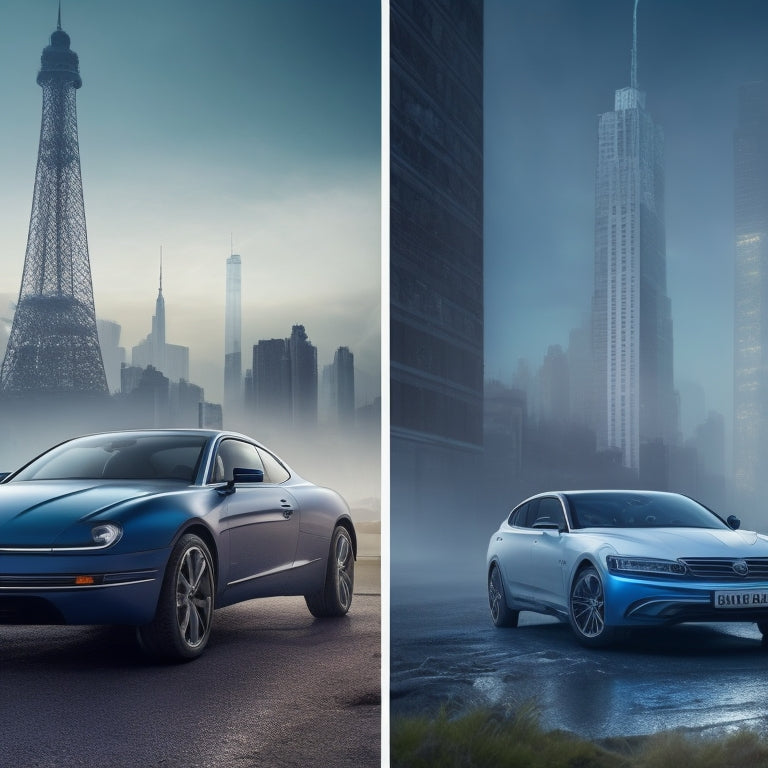
Electric Cars Set to Outprice Petrol Vehicles
Share
By 2027, electric vehicles are expected to reach price parity with petrol vehicles in every light vehicle segment in Europe, driven by declining battery costs and innovative vehicle architectures. This milestone marks an important step towards a low-carbon transportation sector, as electric vehicles become increasingly competitive with their petrol counterparts. As stricter emissions targets and government incentives stimulate demand, the market is poised for a significant shift. As the industry approaches this key milestone, the future of electric vehicles looks promising, and further analysis reveals the complexities and opportunities that lie ahead.
Key Takeaways
• By 2027, electric vehicles are expected to reach price parity with petrol vehicles in every light vehicle segment in Europe.
• Falling battery costs and new vehicle architectures drive the reduction in electric vehicle prices.
• Government incentives are crucial for stimulating demand and reducing electric vehicle costs through economies of scale.
• Electric cars and vans are projected to surpass fossil-fuel prices by 2027 in Europe, driven by stricter CO2 targets and production incentives.
• Price parity milestones are expected for different electric vehicle segments by specific years, accelerating the shift to a low-carbon transportation sector.
Electric Vehicles Reach Price Parity
By 2027, electric cars and vans are expected to be cheaper than their fossil-fuel counterparts in every light vehicle segment across Europe, marking a significant milestone in the shift to a low-carbon transportation sector. This price parity is driven by falling battery costs, new vehicle architectures, and dedicated production lines.
As EV adoption accelerates, government incentives will play an essential role in stimulating demand and driving down costs. Early investment in EV production and sales is vital to achieving economies of scale and increasing consumer buy-in.
As EVs become more affordable, we can expect to see a significant surge in demand, paving the way for a low-carbon transportation sector.
Stricter Emissions Targets Needed
Rigorous emissions targets are essential to driving the shift to a low-carbon transportation sector, as the current pace of decarbonization remains insufficient to meet the EU's 2050 climate neutrality goal.
Stricter regulations are necessary to stimulate the transformation to electric vehicles, and government incentives can play a pivotal role in accelerating this process. The EU must set more ambitious CO2 targets for vehicle-makers, including a new 2027 target, to drive down emissions and increase investment in electric models.
Market Share Projections for EVs
What market share can we expect electric vehicles to capture in the EU by 2035, and what policies are necessary to stimulate their adoption?
According to projections, battery electric cars and vans could reach 100% of new sales by 2035. However, without additional policies, battery electric cars will only reach an 85% market share in the EU by 2035, and e-vans just 83%.
To bridge this gap, strong policies are needed to stimulate the market, such as a faster roll-out of charging points. A thorough charging infrastructure is essential to support widespread EV adoption.
The EU's goal of decarbonizing by 2050 requires accelerated efforts to promote EV adoption, making policy interventions essential to achieving this ambition.
Phasing Out Fossil-Fuel Car Sales
Julia Poliscanova suggests setting an end date in 2035 for fossil-fuel car sales, aligning with the EU's goal of decarbonizing by 2050 and prompting calls for the EU Commission to propose tightening the bloc's car CO2 targets.
This move is vital for accelerating EV adoption and meeting the EU's green legislation goals. Phasing out fossil-fuel car sales will drive investment in electric vehicle production, increasing model availability and driving down costs.
With 63% of urban residents in Europe supporting a ban on selling new combustion engine cars after 2030, the momentum is building towards a fossil-fuel-free future. Strong policies, such as stricter CO2 targets and e-van sales quotas, are necessary to stimulate the market and achieve the EU's decarbonization ambitions.
Unlocking the Full Potential
By 2027, electric cars and vans are set to surpass their fossil-fuel counterparts in price across every light vehicle segment in Europe, marking a pivotal moment in the industry's shift towards a low-carbon future. To fully realize the potential of EV adoption, it is essential to establish stricter CO2 targets and incentivize EV production. This can be achieved by implementing policies that stimulate the market, such as faster roll-out of charging points and e-van sales quotas.
| Segment | Year | Price Parity |
|---|---|---|
| Light Electric Vans | 2025 | Cheaper than Diesel Vans |
| Heavy Electric Vans | 2026 | Cheaper than Diesel Vans |
| Electric Sedans | 2026 | Cheaper than Petrol Sedans |
| Electric SUVs | 2027 | Cheaper than Petrol SUVs |
Frequently Asked Questions
Will Electric Cars Require Special Maintenance Compared to Petrol Cars?
Electric cars will require distinct maintenance compared to petrol cars, with a focus on battery diagnostics and fewer oil checks, necessitating specialized servicing and inspection protocols for peak performance and longevity.
Can Electric Vehicles Be Charged Using Renewable Energy Sources?
Yes, electric vehicles can be charged using renewable energy sources, greatly reducing their carbon footprint. Integrating EVs with renewable grids enables a cleaner transportation sector, further mitigating climate change impacts.
How Will the Increased Demand for EVS Affect the Global Lithium Supply?
As the proverbial "tip of the iceberg" emerges, the increased demand for EVs will strain global lithium reserves, exacerbating mining challenges, and necessitating sustainable extraction practices to meet the burgeoning need for this critical battery component.
Will Governments Offer Incentives for Consumers to Switch to Electric Vehicles?
Governments are likely to offer incentives, such as tax breaks and government subsidies, to encourage consumers to switch to electric vehicles, driving adoption and reducing emissions, thereby supporting the shift to a low-carbon transportation sector.
Can Electric Vehicles Be Recycled at the End of Their Lifespan?
As the first generation of electric vehicles reaches end-of-life, recycling becomes essential. Battery reuse and efficient end-of-life management are key to minimizing waste and maximizing resource recovery, ensuring a sustainable electric vehicle ecosystem.
Related Posts
-

What Tax Deductions Apply to Sustainable Building Materials?
You can claim various tax deductions for sustainable building materials, thanks to over 40 federal tax incentives sup...
-

Green Deck Options: Earth-Conscious Choices for Your Home
You're looking for a deck that not only enhances your home's exterior but also aligns with your eco-friendly values. ...
-

7 Blockchain Tools for Home Energy Management
You can utilize blockchain technology to optimize your home's energy management through innovative solutions like blo...


